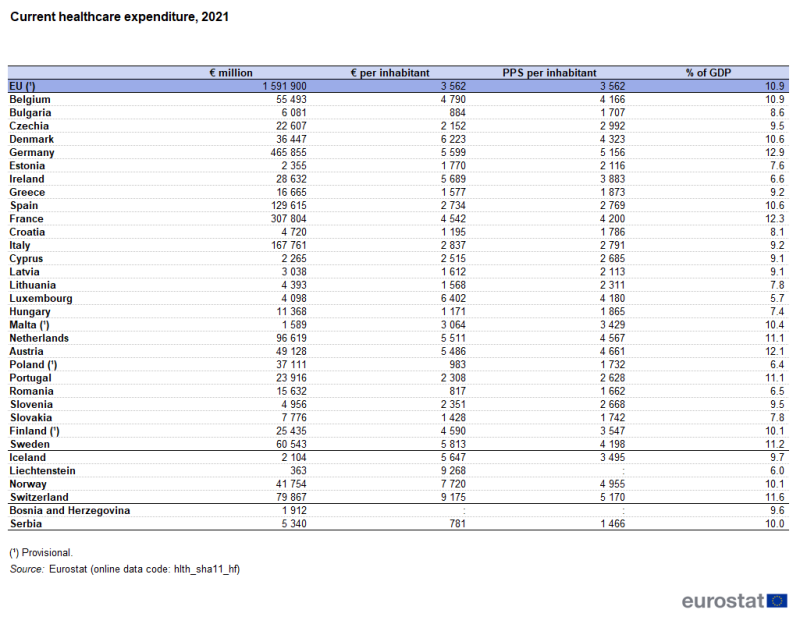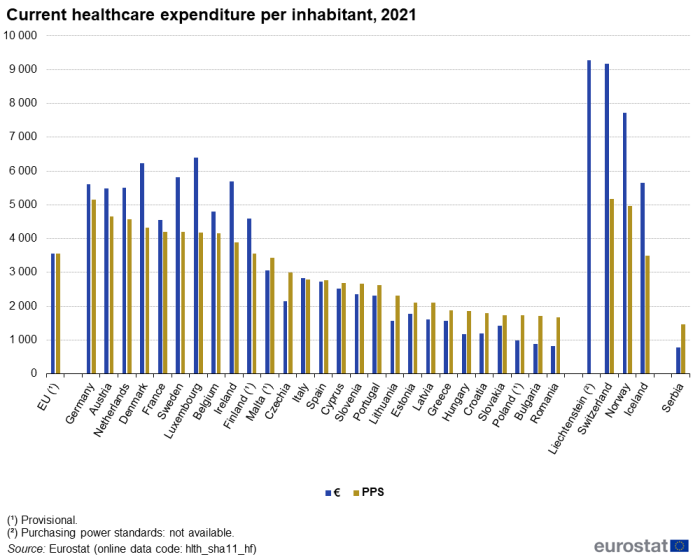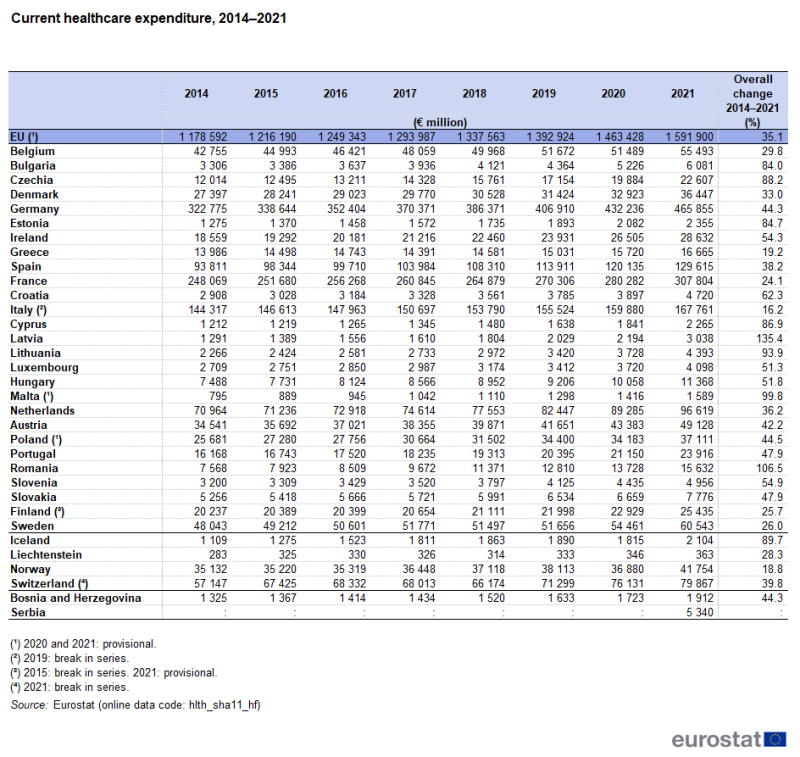Healthcare expenditure statistics - overview
Data extracted in November 2023.
Planned article update: November 2024.
Highlights
Among the EU Member States, Germany (12.9 %), France (12.3 %) and Austria (12.1 %) had the highest current healthcare expenditure relative to GDP in 2021.
Among the EU Member States, the largest expansions (in percentage terms) in current healthcare expenditure per inhabitant between 2014 and 2021 were recorded in Latvia and Romania, where expenditure more than doubled.
Current healthcare expenditure relative to GDP, 2021
This article presents key statistics on expenditure aspects of healthcare in the European Union (EU). More detailed information will be available – with analyses by functions, providers and financing schemes – in a future article. Healthcare systems are organised and financed in various ways across the EU Member States, but universal access to quality healthcare, at an affordable cost to both individuals and society at large, is widely regarded as a basic principle in the EU.
Statistics on healthcare expenditure and financing may be used to evaluate how a healthcare system responds to the challenge of universal access to quality healthcare, through measuring financial resources available for the healthcare sector and the allocation of these resources between healthcare activities (for example, preventive and curative care) or groups of healthcare providers (for example, hospitals and ambulatory centres).
This article forms part of an online publication on Health in the European Union.
It should be noted that data are presented in this article for 2021. Therefore, the data in this article show the impact of the COVID-19 pandemic and its related restrictions. For this reason, particular attention should be paid when comparing 2020 and 2021 data with each other and with data from earlier years.
Full article
Healthcare expenditure
Germany, France and Austria had the highest current healthcare expenditure relative to GDP in 2021
Germany had the highest level of current healthcare expenditure among the EU Member States, valued at €466 billion in 2021. France recorded the second highest level of current healthcare expenditure (€308 billion), followed by Italy (€168 billion) and Spain (€130 billion).
Current healthcare expenditure in Germany, France and Austria was equivalent to 12.9 %, 12.3 % and 12.1 %, respectively, of gross domestic product (GDP), more than in any other EU Member State – see Table 1. The next highest ratios were in Sweden (11.2 %), the Netherlands, Portugal (both 11.1 %) and Belgium (10.9 %). Denmark, Spain, Malta and Finland were the only other EU Member States to record double-digit ratios. Note that current healthcare expenditure in Switzerland was equivalent to 11.6 % of GDP and that Norway and Serbia also had double-digit ratios. By contrast, current healthcare expenditure accounted for less than 7.0 % of GDP in four Member States, with Luxembourg recording the lowest ratio (5.7 %).
Relative to population size and in euro terms, current healthcare expenditure in 2021 was highest among the EU Member States in Luxembourg (€6 402 per inhabitant) and Denmark (€6 223 per inhabitant). It is interesting to note that Luxembourg had the highest ratio per inhabitant despite having the lowest ratio of healthcare expenditure to GDP, reflecting the high level of GDP in Luxembourg. A significant proportion of workers in Luxembourg are cross-border workers and live outside the country and, as non-residents, the expenditure on their healthcare is not included in Luxembourg’s health accounts while their economic activity does contribute to Luxembourg’s GDP. Three of the four EFTA countries included in Table 1 – Switzerland, Liechtenstein and Norway – each reported higher levels of healthcare expenditure per inhabitant than in any of the Member States. Following on from Luxembourg and Denmark, ratios over €5 000 per inhabitant were also observed in Sweden, Ireland, Germany, the Netherlands and Austria. In turn, these were followed at some distance by another group – Belgium, Finland and France – with ratios in the range of €4 542 to 4 790 per inhabitant. There was then a relatively large gap to Malta, Italy, Spain, Cyprus, Slovenia, Portugal and Czechia with ratios in the range of €2 152 to 3 064 per inhabitant. All of the remaining 10 EU Member States recorded average expenditure below €2 000 per inhabitant in 2021, three of these recording an average spend on healthcare below €1 000 per inhabitant: Poland (€983), Bulgaria (€884) and Romania (€817). The ratio between the highest (Luxembourg) and lowest (Romania) levels of expenditure per inhabitant was 7.8 : 1.
These disparities are less apparent when expenditure is expressed in purchasing power standards (PPS). This measure adjusts for differences in price levels between the EU Member States. Germany (5 156 PPS per inhabitant), Austria (4 661 PPS per inhabitant) and the Netherlands (4 567 PPS per inhabitant) recorded the highest ratios of healthcare expenditure per inhabitant in PPS terms. Romania (1 662 PPS per inhabitant) had the lowest ratio. As such, by taking account of price level differences, the ratio between the highest (Germany) and lowest (Romania) levels of healthcare expenditure per inhabitant was considerably lower than the equivalent ratio in euro terms mentioned above, as it was 3.1 : 1.
Developments over time
Table 2 and Figures 2 and 3 highlight the developments in the level of healthcare expenditure in recent years, focusing on a comparison between 2014 and 2021. Note that the analyses in Table 2 and Figure 2 are presented in current price terms and so reflect price changes (inflation and deflation) as well as changes in real expenditure.
Based on the data shown in Table 2, all EU Member States recorded higher healthcare expenditure in 2021 than in 2014. The largest overall increases were observed in Latvia and Romania, where expenditure in 2021 was more than double that in 2014, up 135.4 % and 106.5 %, respectively; these amounted to annual average increases of 13.0 % in Latvia and 10.9 % in Romania. Overall increases of at least 80.0 % between 2014 and 2021 were also observed in Malta, Lithuania, Czechia, Cyprus, Estonia and Bulgaria.
As well as being affected by price changes, comparisons of healthcare expenditure over time can also be influenced by demographic changes. Figure 2 shows the average healthcare expenditure per inhabitant in 2014 and 2021. All EU Member States recorded a higher level of expenditure per inhabitant in 2021 than in 2014. As with the rate of change based on overall expenditure, Latvia and Romania recorded the largest increases, with average expenditure per inhabitant increasing by 149.0 % and 115.0 %, respectively. Lithuania recorded the next largest increase, up 103.0 %.
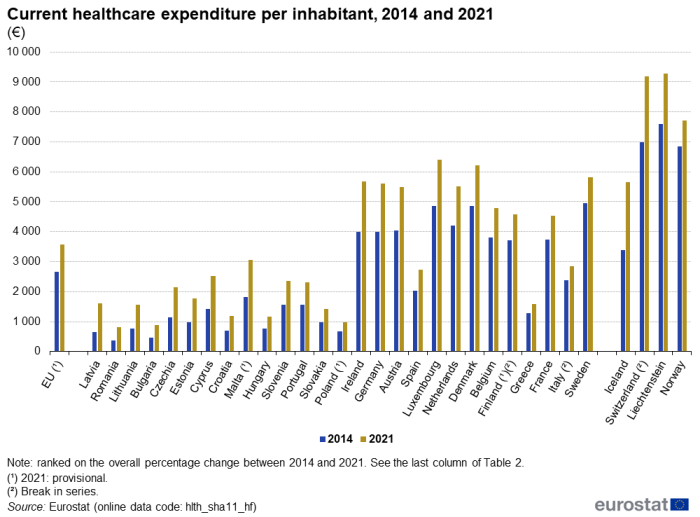
(€)
Source: Eurostat (hlth_sha11_hf)
Figure 3 provides another analysis of the change in overall healthcare expenditure between 2014 and 2021, focusing on the ratio between this expenditure and GDP. Healthcare expenditure and GDP are both influenced by price changes and so, when combining the two indicators in a ratio, the impact of inflation may cancel out to some degree: this depends on the extent to which the price changes related to healthcare expenditure are similar to those experienced in the economy as a whole.
Twenty-six EU Member States reported a higher ratio of healthcare expenditure to GDP in 2021 than in 2014, while Ireland reported a lower ratio, 2.9 percentage points lower in 2021 (6.6 %) than it had been in 2014 (9.5 %). In the Member States where the ratio was higher in 2021 than it had been in 2014, the increase was less than 2.0 percentage points in most cases. Larger increases were observed in Cyprus (up 2.2 percentage points) and Latvia (up 3.7 percentage points). Among the non-EU countries shown in Figure 3 with data for both years, all recorded higher ratios in 2021 than in 2014.
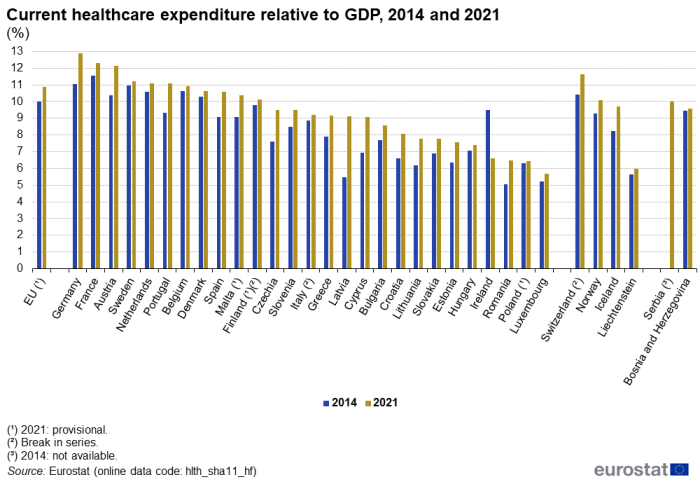
(%)
Source: Eurostat (hlth_sha11_hf)
Source data for tables and graphs
![]() Healthcare expenditure statistics – overview: tables and figures
Healthcare expenditure statistics – overview: tables and figures
Data sources
The data for the EU, Malta, Poland and Finland for 2021 are provisional.
Tables in this article use the following notation:
- a colon ' : ' is used to show where data are not available.
Current healthcare expenditure
Current healthcare expenditure quantifies the economic resources dedicated to health functions, excluding capital investment. Current healthcare expenditure is primarily concerned with healthcare goods and services that are consumed by resident units, irrespective of where that consumption takes place (it may be in the rest of the world) or who is paying for it. As such, exports of healthcare goods and services (to non-resident units) are excluded, whereas imports of healthcare goods and services for final use are included.
System of health accounts – methodology
Eurostat, the Organisation for Economic Co-operation and Development (OECD) and the World Health Organization (WHO) established a common framework for a joint healthcare data collection exercise. The data collected relates to healthcare expenditure following the methodology of the system of health accounts (SHA).
The SHA shares the goals of the system of national accounts (SNA): to constitute an integrated system of comprehensive, internally consistent and internationally comparable accounts, which should as far as possible be compatible with other aggregated economic and social statistical systems. Health accounts provide a description of the monetary flows related to final consumption expenditure on healthcare goods and services. Health accounts are used in two main ways: internationally, where the emphasis is on a selection of comparable expenditure data; nationally, with more detailed analyses of healthcare spending and a greater emphasis on comparisons over time.
For more details on health accounts, see A system of health accounts, 2011 – revised edition. The core set of SHA tables addresses three basic questions: i) what kinds of healthcare goods and services are consumed, ii) which healthcare providers deliver them and, iii) which financing schemes are used to finance the expenditure?
Healthcare expenditure – legal basis
Commission Regulation (EU) 2021/1901 of 29 October 2021 as regards statistics on health care expenditure and financing is the legal basis for data collection according to SHA 2011 methodology for healthcare expenditure. Commission Regulation (EU) 2015/359 of 4 March 2015 implementing Regulation (EC) No 1338/2008 as regards statistics on healthcare expenditure and financing applied to data from reference year 2014 to 2020.
Statistics on healthcare expenditure are documented in a background article which provides more information on the scope of the data, the legal framework, the methodology employed, as well as related concepts and definitions.
Context
Health systems across the globe are developing in response to a multitude of factors, including: new medical technology and improvements in knowledge providing new health services and a greater access to them; changes in health policies to address specific diseases and demographic developments; new organisational structures and more complex financing mechanisms. However, access to healthcare and greater patient choice is increasingly being considered against a background of financial sustainability.
The European Commission adopted a Strategic Plan for the period 2020–2024. In order to improve the quality and effectiveness of public expenditure and contribute to prosperity and social cohesion, the European Commission seeks to provide expertise on health systems and support actions that help prevent and reduce the impact of ill-health on individuals and economies, while encouraging and supporting innovation and the uptake of modern technologies for better care delivery and cost-effectiveness.
The Directorate-General for Health and Food Safety has constituted a list of 88 European core health indicators (ECHIs) for monitoring progress in relation to health policy and broader objectives. Among these, it recommends specifically following developments for:
Direct access to
Online publication
Methodology
Healthcare expenditure statistics articles
General health statistics articles
- Health (hlth), see:
- Health care (hlth_care)
- Health care expenditure (SHA 2011) (hlth_sha11)
- A system of health accounts 2011 – revised edition
- Healthcare expenditure (SHA 2011) (ESMS metadata file – hlth_sha11_esms)
Implementing legislation
